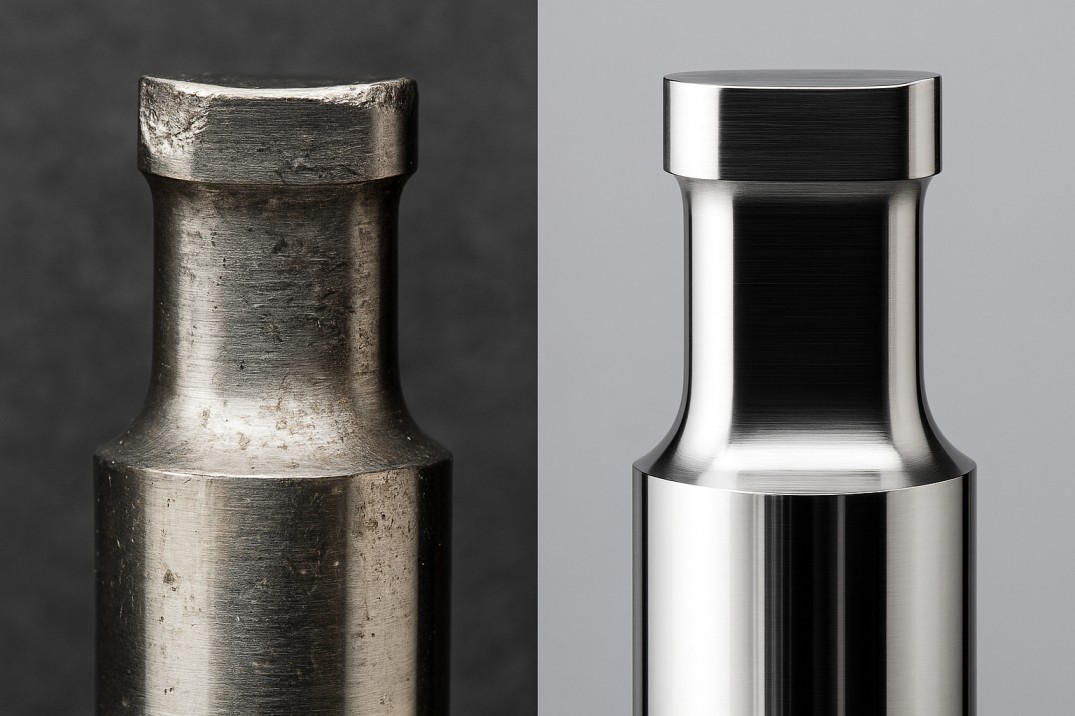Tablet punches and dies are the workhorses of pharmaceutical manufacturing, but like any precision tooling, they experience wear over time. Understanding wear patterns and knowing when to replace your tooling is crucial for maintaining product quality, reducing downtime, and optimizing manufacturing costs. This comprehensive guide explores the science behind punch and die wear, common failure modes, and practical strategies for maximizing tooling life.
The Science of Tooling Wear
Tablet compression subjects punches and dies to extreme forces, often exceeding 50,000 pounds per square inch. This repeated stress, combined with abrasive tablet formulations and environmental factors, gradually degrades the tooling surfaces through several mechanisms:
Adhesive Wear occurs when tablet material bonds to the punch or die surface, creating microscopic welds that are subsequently torn away during ejection. This is particularly common with formulations containing magnesium stearate or other sticky excipients.
Abrasive Wear results from hard particles in the tablet formulation grinding against the tooling surfaces. Microcrystalline cellulose, dicalcium phosphate, and other common excipients can act as abrasives, especially when present in high concentrations.
Corrosive Wear happens when moisture or chemical reactions between the formulation and tooling material cause surface degradation. This is most prevalent in humid environments or with hygroscopic formulations.
Fatigue Wear develops from repeated stress cycles, causing microscopic cracks that eventually propagate into larger defects. This type of wear is inevitable but can be minimized through proper tooling design and maintenance.
Common Wear Patterns and Their Causes
Upper Punch Wear
The upper punch face experiences the most severe wear due to direct contact with the tablet formulation during compression. Common wear patterns include:
Central Wearing appears as a circular depression in the punch face center, typically caused by uneven force distribution or excessive compression force. This pattern often indicates that compression parameters need adjustment.
Edge Chipping manifests as small chips or cracks around the punch face perimeter. This usually results from impact damage during handling or excessive lateral forces during compression.
Land Wear occurs around embossed areas where the punch surface gradually rounds off, reducing the sharpness of tablet markings. This is particularly problematic for tablets requiring crisp, legible embossing.
Lower Punch Wear
Lower punches face unique challenges due to their role in tablet ejection and interaction with the die wall:
Tip Wear appears as flattening or rounding of the punch tip, often accompanied by increased ejection forces. This pattern typically indicates excessive friction between the punch and die.
Barrel Wear shows as longitudinal scratches or grooves along the punch barrel, usually caused by misalignment or contamination in the punch guides.
Head Wear occurs at the punch head where it contacts the cam tracks, potentially causing timing issues and inconsistent tablet weights.
Die Wear Patterns
Dies experience wear primarily in the bore and chamfer regions:
Bore Scoring appears as vertical scratches in the die cavity, often caused by abrasive particles or inadequate lubrication. This can lead to tablet capping and lamination issues.
Chamfer Wear manifests as rounding or chipping of the die entrance, making tablet ejection more difficult and potentially causing edge defects.
Dimensional Changes occur gradually as the die bore increases in diameter, leading to tablets with reduced hardness and potential weight variation.
Visual Inspection Techniques
Regular visual inspection is your first line of defense against tooling failure. Develop a systematic approach using proper lighting and magnification:
Daily Inspections should focus on obvious damage such as chips, cracks, or excessive buildup of tablet material. Use a 10x magnifying glass to examine punch faces and die bores for early wear signs.
Weekly Detailed Inspections require more thorough examination using microscopes or digital imaging systems. Look for subtle changes in surface texture, early signs of fatigue cracking, or gradual dimensional changes.
Monthly Comprehensive Assessments should include dimensional measurements using precision gauges and comparison with new tooling specifications. Document any changes in punch length, die bore diameter, or surface finish.
Measurement and Documentation
Accurate measurement and documentation are essential for tracking tooling performance and optimizing replacement schedules:
Dimensional Measurements should be taken at consistent intervals using calibrated equipment. Key measurements include punch length, die bore diameter, and critical dimensions of embossed features.
Surface Finish Analysis can be performed using profilometers or surface roughness testers to quantify changes in tooling surfaces. Establish baseline measurements for new tooling and track degradation over time.
Photographic Documentation provides valuable visual records of wear progression. Use consistent lighting and magnification to create comparable images over time.
Performance Indicators
Several tablet quality parameters can indicate developing tooling wear:
Tablet Weight Variation often increases as die bores enlarge or punch lengths change. Monitor weight uniformity closely and investigate when variation exceeds acceptable limits.
Hardness Degradation frequently occurs as tooling wear progresses, particularly with die bore enlargement. Track hardness trends and correlate with tooling condition.
Ejection Force Increases typically indicate developing friction between punches and dies. Monitor ejection forces and investigate sudden increases that might indicate scoring or dimensional changes.
Tablet Defects such as capping, lamination, or picking often correlate with specific wear patterns. Maintain detailed records linking defect occurrences with tooling condition.
Replacement Decision Matrix
Developing a systematic approach to replacement decisions helps optimize tooling costs while maintaining quality:
Critical Wear Limits should be established for each tooling dimension based on tablet specifications and quality requirements. Replace tooling when these limits are approached, not exceeded.
Cost-Benefit Analysis should consider tooling cost, production volume, and quality risk. Sometimes early replacement is more economical than risking batch failures or rework.
Production Schedule Considerations should factor in tooling availability and changeover requirements. Plan replacements during scheduled maintenance windows when possible.
Extending Tooling Life
Several strategies can significantly extend punch and die life:
Proper Formulation Design can reduce tooling wear by optimizing lubricant levels, minimizing abrasive materials, and ensuring good compressibility. Work with formulation scientists to develop tooling-friendly formulations.
Optimal Compression Parameters balance tablet quality requirements with tooling preservation. Avoid excessive compression forces and ensure proper dwell times for consistent results.
Regular Cleaning and Maintenance prevents buildup of abrasive residues and corrosive materials. Establish cleaning protocols that thoroughly remove tablet material without damaging tooling surfaces.
Proper Storage protects tooling from environmental damage and mechanical harm. Store tooling in controlled environments with appropriate protection from moisture and contamination.
Preventive Maintenance Program
A comprehensive preventive maintenance program is essential for maximizing tooling life:
Scheduled Inspections should be performed at predetermined intervals based on production volume and formulation characteristics. High-abrasion formulations may require more frequent inspection.
Cleaning Protocols should be standardized and documented to ensure consistent results. Use appropriate solvents and techniques that effectively remove residues without damaging tooling surfaces.
Lubrication Management requires careful attention to lubricant selection and application. Use only approved lubricants and establish protocols for consistent application.
Storage Procedures should protect tooling from damage and contamination. Maintain proper environmental conditions and use appropriate storage containers or systems.
Cost Optimization Strategies
Balancing tooling costs with production requirements requires strategic thinking:
Lifecycle Cost Analysis should consider initial tooling cost, maintenance expenses, and replacement frequency. Sometimes higher-quality tooling provides better long-term value despite higher initial costs.
Inventory Management requires balancing tooling availability with carrying costs. Maintain adequate spare tooling while avoiding excessive inventory levels.
Refurbishment Programs can extend tooling life for certain wear patterns. Evaluate refurbishment options based on wear severity and economic considerations.
Supplier Partnerships can provide valuable expertise and support for tooling optimization. Work closely with tooling suppliers to develop strategies that meet your specific needs.
Advanced Monitoring Technologies
Modern technologies offer new possibilities for tooling condition monitoring:
Digital Imaging Systems can provide detailed documentation of tooling condition and track wear progression over time. These systems often include measurement capabilities and data management features.
Force Monitoring Systems can detect changes in compression and ejection forces that indicate developing tooling problems. These systems provide early warning of potential issues.
Automated Inspection Systems can perform consistent, objective evaluations of tooling condition. These systems are particularly valuable for high-volume operations with multiple tooling sets.
Quality Assurance Integration
Tooling management should be integrated with overall quality assurance programs:
Documentation Requirements should align with regulatory expectations and internal quality standards. Maintain detailed records of tooling condition, maintenance activities, and replacement decisions.
Change Control Procedures should govern tooling modifications and replacements to ensure consistent product quality. Evaluate the impact of tooling changes on tablet specifications.
Validation Considerations may require demonstration of tooling performance and consistency. Plan validation activities to include tooling condition assessments and performance verification.
Conclusion
Understanding punch and die wear patterns is essential for maintaining efficient tablet production and consistent product quality. By implementing systematic inspection procedures, establishing clear replacement criteria, and adopting preventive maintenance strategies, manufacturers can optimize tooling performance while controlling costs.
The key to success lies in developing a comprehensive tooling management program that balances quality requirements with economic considerations. Regular monitoring, accurate documentation, and proactive maintenance will ensure that your tooling investment provides maximum value while supporting reliable pharmaceutical manufacturing operations.
Remember that tooling wear is not just an operational concern – it directly impacts product quality, regulatory compliance, and manufacturing efficiency. By treating tooling as a critical component of your quality system, you can achieve better results while building a sustainable, cost-effective production operation.
For more information about tablet tooling solutions and expert consultation on optimizing your punch and die management program, contact our technical team.

